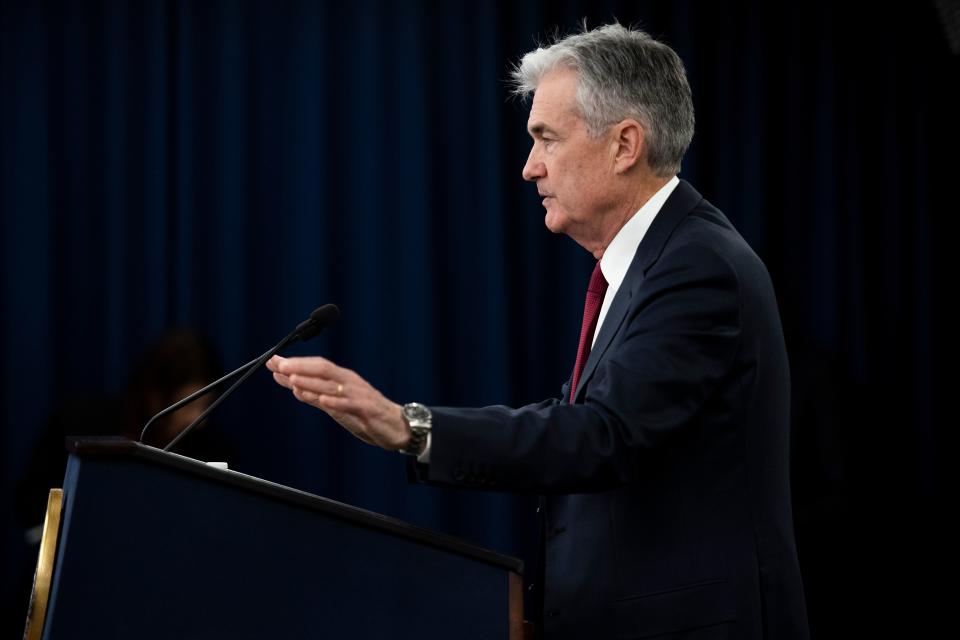Two emergency meetings in two weeks: How the Fed ended up back at zero
An emergency 50 basis point cut from the Federal Reserve on March 3 was not enough to stop market turmoil, and on Sunday night, the central bank made another abrupt announcement by slashing rates to zero.
Fed Chairman Jerome Powell said the central bank’s actions over the past two weeks did not calm financial conditions as policymakers hoped, spurring the second emergency meeting.
In addition to pushing rates down to zero, the Fed also restarted the crisis-era policy of asset purchases, announced U.S. dollar swap lines, and eased bank rules to encourage lending.
After the Fed’s 50 basis point cut, the central bank’s New York office attempted to flood money markets with money through its temporary repurchase agreement operations.
The repo market provides financing for banks and broker-dealers at the center of the economy, allowing the levered institutions to cover positions on their balance sheet by lending sums of cash to one another. The New York Fed has been offering its own repos since last September’s flare up in money markets.
Here is a recap of the Fed actions taken over the last couple of weeks:
Tuesday, March 3:
The Fed abruptly slashes interest rates by 50 basis points to a target range of between 1.00% and 1.25%. A statement detailing the unanimous decision: “The fundamentals of the U.S. economy remain strong. However, the coronavirus poses evolving risks to economic activity.”
Sunday, March 8:
JPMorgan’s global markets strategy team writes that high yield and U.S. dollar markets are flashing early signs of stress, warning that “credit channels might start amplifying the economic fallout from the COVID-19 crisis.”
Monday, March 9:
Oil prices crash after production cut negotiations between Russia and Saudi Arabia collapse. Overnight, bond yields fall sharply as the 10-year touches an all-time low of 31 basis points.
Before the opening bell, the New York Fed announces that it is expanding the size of its overnight repo operations from $100 billion to $150 billion.
Wednesday, March 11:
New York Fed further expands overnight repo operations to $175 billion.
New York Fed offers longer-term agreements: a $45 billion two-week term repo and three one-month term repos of $50 billion each.
Bond yields rise as the stock market extends its sell-off, defying the normal dynamic of Treasury yields falling as investors shift from equity positions into risk-off assets.
Evercore’s Krishna Guha and Ernie Tedeschi write that Treasury markets, largely seen as among the most liquid markets in the world, are “starting to feel dysfunctional.”
Behind the scenes, Fed chairman Jerome Powell worries that repo may not be calming the market as needed. Powell recalled on March 16 said “the take-up [of the March 11 repo operations] was not as high as many had expected.”
Powell decides that the next day, the Fed would need “to go direct here, rather than [try] to intermediate through the dealers.”
Thursday, March 12
New York Fed announces longer-term Treasury purchases and repo operations amounting to more than $1 trillion to “address highly unusual disruptions in Treasury financing markets associated with the coronavirus outbreak.”
Longer-term repo operations: a $500 billion one-month operation and another $500 billion three-month operation.
Remixing Treasury purchases: $60-billion-a-month pace of T-bill purchases will now be revised to include Treasuries “across a range of maturities.”
Extension of existing short-term repos: $175 billion overnight operation and at least $45 billion in two-week term repos.
Powell decides to move the pre-scheduled March 18 meeting up to Sunday afternoon.
Friday, March 13
New York Fed announces details of its first round of revised Treasury purchases, including bonds as long as 30-years in maturity.
Open market purchase adds $37 billion of securities.
Powell commits to bringing together the full FOMC on Sunday afternoon, noting that the direct Treasury purchases improved market function “a little bit,” but felt “it wasn't what we needed.”
Saturday, March 14
Number of coronavirus cases confirmed in the U.S. surpasses 2,800 and the death toll reaches 58, according to the U.S. Centers for Disease Control and Prevention.
Sunday, March 15
Federal Reserve announces emergency decision at 5 p.m. ET
Slashes interest rates by 100 basis points to a target range of between zero and 0.25%.
Launches $700 billion quantitative easing program to purchase U.S. Treasuries ($500 billion) and agency mortgage-backed securities ($200 billion).
Unveils U.S. dollar liquidity swap line arrangements with five other major central banks around the world.
Encourages banks to tap into capital and liquidity buffers or access the discount window to support lending. Also reduces reserve requirement ratios to zero.
President Donald Trump says he is “very happy” with the Fed’s actions.
Powell says use of “full range of tools” are aimed at supporting the economy. Powell says only fiscal policy can address the health crisis and “direct relief to particular populations and groups.”
Monday, March 16
New York Fed announces an additional overnight repo operation of $500 billion.
President Donald Trump holds a teleconference with U.S. governors as the Republican-controlled Senate debates a relief package passed by the Democrat-controlled House of Representatives.
The Dow Jones Industrial Average closes the day with the worst loss by points in history, falling 2,997 points, or 12.93%.

Brian Cheung is a reporter covering the Fed, economics, and banking for Yahoo Finance. You can follow him on Twitter @bcheungz.
Federal Reserve still has 'bazookas left in the war chest' to counter coronavirus
Federal Reserve slashes rates to zero, restarts QE in emergency Sunday announcement
Energy-exposed banks attempt to bounce back after second punch from oil prices
Fed's move to tap liquidity operations will 'buy time' on more rate cuts: Barclays
'Talk ourselves into a recession': Bank in coronavirus hotspot has doubts over Fed rate cut
Read the latest financial and business news from Yahoo Finance
Follow Yahoo Finance on Twitter, Facebook, Instagram, Flipboard, SmartNews, LinkedIn, YouTube, and reddit.
